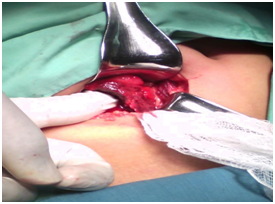Journal of
eISSN: 2373-4426


Case Report Volume 10 Issue 1
Paediatric Surgery Service, Clinica Santa Fe, Nicaragua
Correspondence: Jonathan Garcia, Paediatric Surgery Service, Clinica Santa Fe, Matagalpa, Nicaragua
Received: August 16, 2019 | Published: January 28, 2020
Citation: Garcia J. Primary torsion of epliplon major as a cause of acute abdomen. J Pediatr Neonatal Care. 2020;10(1):9-10. DOI: 10.15406/jpnc.2020.10.00405
It presents the clinical case of a pediatric patient of 9 years old male, of urban origin who underwent surgery for acute abdomen box with preoperative diagnosis of complicated appendicitis, finding the findings transquirúrgicos a primary omental torsion greater, performed a case report and a review of existing literature.
Keywords: acute abdomen, twisting, greater omentum
The primary omental torsion is a most uncommon cause of abdominal pain in childhood. It was first described by Eitel and is rarely suspected at first diagnosis before the surgery. In most extensive revisions, only 15% of cases occur in the pediatric age and also occurs in 0.1% of all laparotomy performed in diagnosing appendicitis. Clinically mimics the symptoms of appendicitis, with intense pain in the right iliac fossa, fever and defense muscle tenderness. The treatment is surgical and evolution is usually favorable.1
Is patient Male 9 years old, who presented to the emergency abdominal pain 26 hours of evolution associated with loss of appetite, fever free without vomiting. Tests reveal no additional inflammatory response (complete blood count unchanged); Abdominal ultrasound reports net in the right iliac fossa and observed hypoechoic image, which simulates the appendix; physical examination palpable mass in the right flank region of well defined edges smooth tender to palpation, with Mcburney positive sign as a sign of rebound; so before deciding described surgical treatment and is taken to the operating room with pre - operative diagnosis of complicated appendicitis. She underwent laparotomy incision umbilical transverse right infrastructure, finding appendix retrocecal no pathological changes, however observed primary omental torsion greater with ischemic changes this, so it is done omentectomy partial (Figure 1). Torque greater omentum is a pathological situation in which the body rotates on its axis axial until producing a compromise vascular strangulation thereof, necrosis and/or infarto.2 The primary twist has no known cause but speaks of predisposing factors, such as changes in the consistency of the omentum, anatomical malformation of the same or vascular abnormalities associated with triggers, such as obesity, abdominal trauma, violent exercise or hiperperistaltismo.3 The pictures produced by twisting secondary are more common and include illness herniaria,4 pictures of intra-abdominal inflammation, prior laparotomy or tumors, others, that make the free edge of the omentum is set to these structures.

Figure 1 Primary omental torsion greater with ischemic changes this, so it is done omentectomy partial.
The main clinical manifestation of torsion of the omentum greater abdominal pain whose location depends on the size of the portion and omentum afectado;5 The lower right quadrant is the most common location. May include nausea, vomiting, fever, and in exceptional cases, you may feel a mass. Laboratory data are less expressive and plain abdominal radiography revealed no findings significativos.6 Throughout the literature the differential diagnosis has faced in a systematic manner with the senior officials of acute abdomen frequently, including appendicitis, cholecystitis and diverticulitis.
Other conditions of the greater omentum, which cause abdominal pain and should be differentiated, are myocardial segmental epiplón7 and a rare form of primary epiploitis pseudotoumoral. The etiology of segmental infarction of omentum may be idiopathic or associated with vascular disease, previous quirúrgias adhesions, abdominal trauma or torsion limited, and examination by ultrasound may be useful and steer toward a primary disease of the omentum (Figure 2).8–10
The primary omental torsion larger, clinically behaves like a picture of acute abdomen in children whenever their management should be operative by the probability of developing sepsis pediatric patients than adults. With special studies such as Computed Tomography, if we make more accurate diagnosis, but the behavior is always the same.
None.
The authors have no conflicts of interest to declare.
None.

©2020 Garcia. This is an open access article distributed under the terms of the, which permits unrestricted use, distribution, and build upon your work non-commercially.